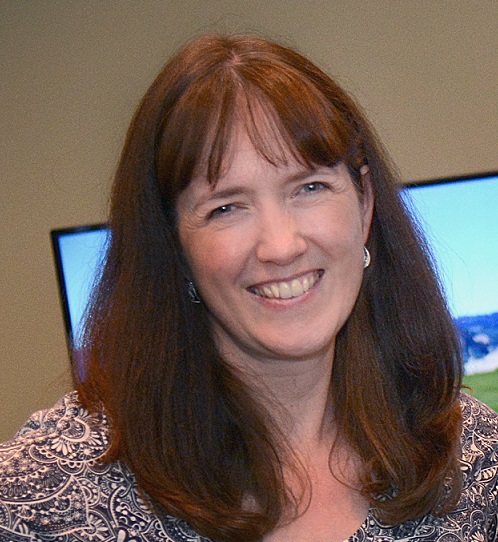
Safe-D student Alexandria Noble (VT/VTTI) interviewed Ms. Higgins about her experience with her Safe-D Projects as part of the Safe-D Student and Faculty Interview Chain. Read on to learn more about Ms. Higgins and her research!
Laura Higgins is a Safe-D UTC Associate Research Scientist at TTI. Ms. Higgins has offered her technical expertise on the following projects:
- Project 01-004: Driver Training for Automated Vehicle Technology
- Project 02-016: Older Drivers and Transportation Network Companies: Investigating Opportunities for Increased Safety and Improved Mobility
- Project 02-010: Safety Perceptions of Transportation Network Companies (TNCs) by the Blind and Visually Impaired (BVI).
What are your research interests?
Throughout my career, I have had the opportunity to work on a whole range of projects. My biggest research interests involve people’s understanding of the roadway and travel systems that they are using. One of my first projects focused on how well older people understood transit information (e.g., bus time table leaflets, route maps, route numbers, etc.) As the transportation landscape continues to evolve, it is essential to understand how users perceive their environment. It is important to understand, especially when it comes to automated vehicle systems, do users trust it? What is their level of confidence and comfort, and how well do they understand how the technology works?
What did you obtain your degree(s) in and where?
B.S., Bioengineering, Texas A&M University
M.S., Industrial Engineering, Texas A&M University
How did you end up working at your current institute? Describe the path that led you to your current position.
When I started undergrad at Texas A&M I wanted to go to vet school. I majored in Bioengineering and while I enjoyed parts of bioengineering there were parts of it that weren’t for me. I completed a technical elective in Human Factors Engineering and decided to complete a Masters degree in Human Factors through Texas A&M’s Industrial Engineering program. My graduate research was at the Texas A&M Transportation Institute and my project was funded by the Southwest Regional UTC.
In 1994, after completing my Masters I was hired by the transportation planning division of TTI. Now I am an Associate Research Scientist at TTI where I work on a variety of projects.
How did you hear about the Safe-D National UTC and how did you get involved with this Safe-D project?
I got involved in two ways right after the UTC was awarded: Worked with Mike Manser on the first stages of the Driver Training for Automated Vehicle Technology project, and I worked with Sue Chrysler to coordinate the Summer Undergraduate Research Internships.
What was your role in the Safe-D projects that you worked on? Any major findings thus far that you can share publicly, and how the outcomes of your project will impact transportation safety.
Driver Training for Automated Vehicle Technology I worked closely with students to help develop focus groups and training. I mentored students (Ashley Shortz and Rachel Sable), assisted in the research development, and final report.
For Safety Perceptions of Transportation Network Companies (TNCs) by the Blind and Visually Impaired (BVI) I was primarily involved with the literature review. I worked to identify existing technologies and tools that people with visual impairments use to navigate the world which was fascinating. I also helped develop the survey that went out to participants to get additional information.
Older Drivers and Transportation Network Companies: Investigating Opportunities for Increased Safety and Improved Mobility was addressing similar questions to the Safety Perceptions of TNCs for BVIs study, so it was interesting to see the results for those two projects. What it fundamentally comes down to the element of understanding how it works and trusting how it works. Trust is the crux of the issue for both of those projects. “Do I get it? Do I know how to use it? If I use it is anything bad going to happen?”
I was involved in the focus groups and developing deliverables for this project. I also had the opportunity to mentor summer interns and graduate students, Ashley Shortz & Eric Wheeler. The students developed a lot of the Technology Transfer materials.
We are seeing a lot of disruptive forces in transportation right now – all three of these projects have the potential to be very impactful in the future.
How is your team sharing the results of your project with other transportation researchers, practitioners, and/or the general public?
Safety Perceptions of Transportation Network Companies (TNCs) by the Blind and Visually Impaired (BVI) (02-010) has developed a podcast to disseminate information to people with visual limitations. They have also held brown bags on multiple occasions for various audiences which summarized the research conducted under this project.
Older Drivers and Transportation Network Companies: Investigating Opportunities for Increased Safety and Improved Mobility (02-016) has developed materials that can be used for technology transfer and a brochure to supplement the presentation and for general dissemination that emphasizes the main points in the presentation.
Do you expect any follow-on studies to result from the work that you are conducting/have conducted?
The PIs of those studies may have more specific ideas about follow-ons to those particular topics. In general, technology is going to keep evolving. Services are going to keep changing. Users’ trust in the transportation network companies is going to be an essential part of research for quite some time. As the technology continues to evolve and as service options continue to evolve they’re going to have to continue to address security questions and safety questions. With each new iteration, what do people understand, what are they confident in operating, and what do they trust? Because if they don’t trust it they won’t use it, or will only use it as a very last resort.
What is your favorite part about working on UTC projects?
I enjoyed all three of these UTC projects, but my favorite for the in the moment work was the older driver project and that was because I got to do two things that I love to do. I love to do focus groups. When conducting a focus group you always have an idea of the answers that you’re likely to get, but there’s nearly always one set of topics that you didn’t expect. It’s always fascinating. Also, for an entire summer I got to work with two students, Ashley Shortz & Eric Wheeler who were both tackling a skill set they never worked with before. Two technically brilliant students who were asked to create a presentation and a booklet that would speak to an older and non-technical audience. They demonstrated a willingness to jump in and give it a shot and learned quickly with feedback.
What advice do you have for a student, like me, who is pursuing a similar career path as yourself?
I was about 14 years into my journey before I was actually doing human factors research as my primary effort. I think this has made it a little more difficult to establish expertise within a particular topic area. I would recommend to young researchers that if you really want to become one of the national or world experts in a particular field or topic area start working towards that early.
What I have been able to do:
Due to the diverse nature of my work, I am more willing to jump in with something unfamiliar. Having a touch of that adaptability has been extremely valuable for me. The transportation research landscape is ever-changing, be ready to pivot.
